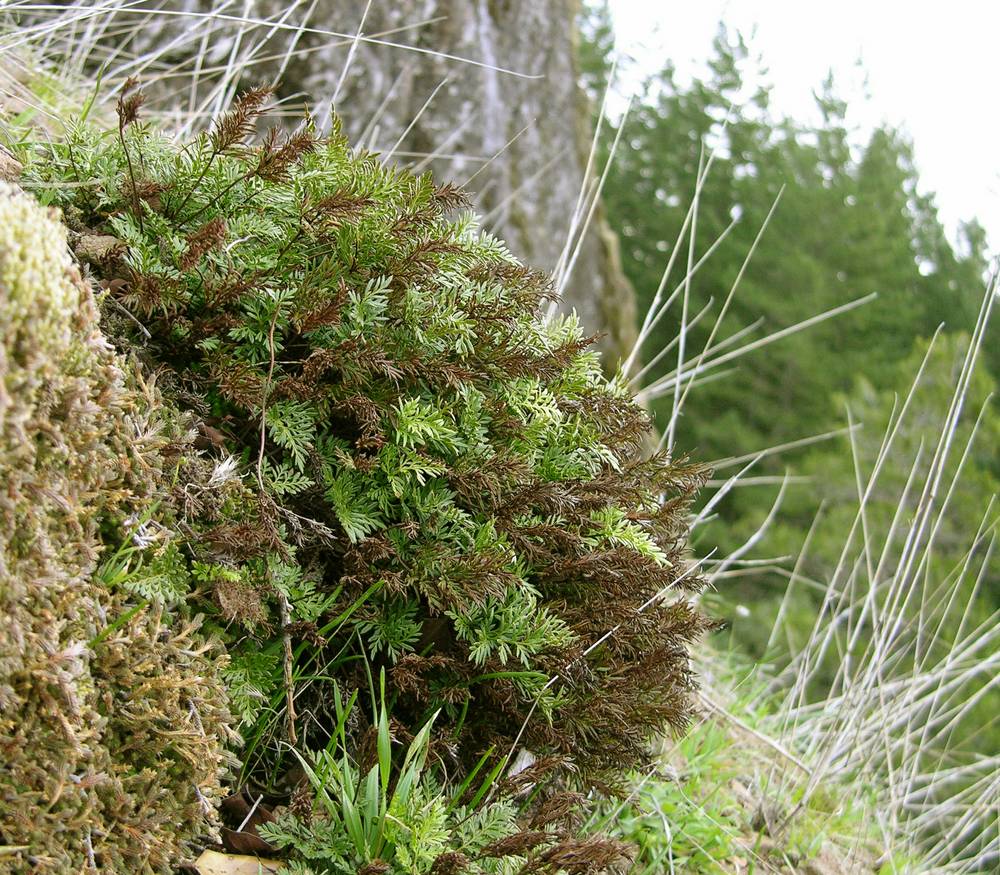Aspidotis densa
Pteridaceae
Indian's dream, podfern
brake family
short, ascending; much-branched and forming a caudex;
scales stiff; narrow and dark.
stout and erect/ascending or more slender and creeping, often branched;
scales and/or hairs present.
usually evergreen in dense clusters from the caudex; up to 25 cm long, monomorphic to slightly dimorphic; most or all leaves erect and fertile; some leaves smaller; non-fertile; and spreading.
monomorphic or dimorphic, circinate or non-circinate.
long and slender, often much longer than the blades; dark purplish brown, glabrous and glossy; dark color usually extending to the proximal part of the rachis;
distal rachis and rachillae green.
3-pinnate; up to about 6 cm; ovate, glabrous; leathery.
with a wide range of variation in dividedness and indumentum.
of non-fertile leaves; where present, narrowly ovate or oblong, toothed, fertile segments linear; dense, spreading and twisted adaxially, 3–10 mm long.
linear; pale, continuous; parallel to and slightly inside the segment margins.
covering the abaxial surface; except for the midrib area and the apex, partially covered by the false indusium.
borne abaxially on simple, forked or anastomosing veins, not aggregated into distinct sori, often appearing to cover the leaf undersurface or form (sub)marginal lines;
indusia absent; false indusia formed from recurved leaf margins present or not.
trilete; tetrahedral often with a hemispherical distal section; wall ornamentation various.
mostly reniform or heart-shaped; flat, green.
=60.
Aspidotis densa
Pteridaceae
Forests, grasslands, rocks and dry to moist soil. 0–2200 m. BW, Casc, CR, ECas, Sisk, WV. CA, ID, NV, WA; western and northeastern North America. Native.
Cosmopolitan. At least 50 genera and 1000 species; 6 genera treated in Flora.
Pteridaceae is a large family in the Polypodiales, currently with five fairly well-defined subfamilies (Christenhusz et al. 2011). Oregon’s three subfamilies with genera are: Cryptogrammoideae (Cryptogramma), Cheilanthoideae (Aspidotis, Cheilanthes, Pellaea, Pentagramma), Vittarioideae (Adiantum, formerly placed in Adianteae).
Duncan Thomas
- Local floras:
BC,
CA,
OR,
WA
- Local Web sites:
CalFlora,
CalPhotos,
Flora NW,
PNW Herbaria
WildflowerSearch
iNaturalist (observations)
USDA Plants Database
- LBJ Wildflower Center
- SEINet
- Plants of the World Online
- Encyclopedia of Life
- Wikipedia
- Google Image Search
- Local floras:
CA,
OR
- Local Web sites:
CalFlora,
CalPhotos,
Flora NW,
PNW Herbaria
WildflowerSearch
iNaturalist (observations)
- LBJ Wildflower Center
- SEINet
- Plants of the World Online
- Encyclopedia of Life
- Wikipedia
- Google Image Search



